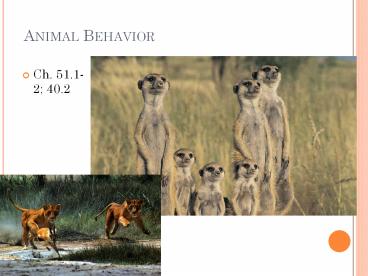Animal Behavior - PowerPoint PPT Presentation
1 / 9
Title:
Animal Behavior
Description:
Title: Animal Behavior Last modified by: Lake Stevens Document presentation format: Custom Other titles: Gill Sans ProN W3 Arial Calibri Century ... – PowerPoint PPT presentation
Number of Views:69
Avg rating:3.0/5.0
Title: Animal Behavior
1
Animal Behavior
- Ch. 51.1-2 40.2
2
- Ethology the study of behavior
- How is this happening?
- Proximate causation-how a behavior occurs
- Genetic basis, physiologic, innate response to a
stimulus - Why is this happening?
- Ultimate causation- why a behavior occurs
- Finding food, regulating temperature,
courtship/mating, communication
3
- What is behavior?
- an action carried out by muscles under control of
the nervous system in response to a stimulus
(based on physiological systems and processes) - everything an organism does and how it does it,
response to stimuli in the environment - essential for survival and reproduction and
subject to natural selection - purpose may include communication with other
organisms - examples songbirds, courtship, scent marking,
hunting, maintain homeostasis, migration etc.
4
- Behavioral stimuli may be..
- Environmental
- Hormonal
- sign (color, object, another organism)
- Scent
- circadian rhythms (daily behavior cycles
triggered by light and dark) - physiologic (internal)
5
Animal Communication
- signal stimulus from one organism to another
- communication reception of signals
- may be visual, chemical, tactile, auditory,
pheromones - communication/behaviors are closely related to an
organisms lifestyle and environment (will
determine the type of communication used)
6
- Innate behaviors
- all individuals in a population exhibit the same
behavior despite environment/lifestyle
differences - automatic, fixed, built in response
- triggered by a stimulus
- example migration, hibernation
- Learned behaviors
- modification of a behavior based on experiences
- triggered by a stimulus but variable
- social learning- learning through observing
others - associative learning-associate one environmental
feature with another - classical conditioning (stimulus associated with
outcomepositive/negative reinforcement) - Pavlovs dogs
- operant conditioning (trial and error learning)
- Push lever to get food (mice)
- example tool usage, hunting techniques
- https//www.youtube.com/watch?vJA96Fba-WHk
7
- Homeostasis-maintaining internal balance
- organisms behavior will change in an effort to
maintain balance either internally or with the
environment - negative feedback reduces the stimulus
(returning to a normal state) - temperature regulation, insulin/glucose balance
in blood - positive feedback amplifies the stimulus (takes
farther from normal state) - labor/birth
- carbon emissions and global warming
8
- Taxis change in direction, move away from
(negative) or toward (positive) a stimulus
(directional) - Chemotaxis (chemical)
- Phototaxis (light)
- Kinesis change in rate of movement in response
to a stimulus (non-directional) - Like stimulus (move slowly)
- Dislike stimulusagitated (move quickly)
- Social Behaviors interactions between
individuals (evolutionary adaptations) - language, dominance, altruism, cooperation,
imprinting - Habituation loss of response to stimulus
9
Videos
- Birds of Paradise https//www.youtube.com/watch?v
W7QZnwKqopo - Honey Bees https//www.youtube.com/watch?vnga4Z_H
RUsU - Sage Grouse https//www.youtube.com/watch?vm0M8pZ
nNlnI - Monkeys and tool usage (life series)































